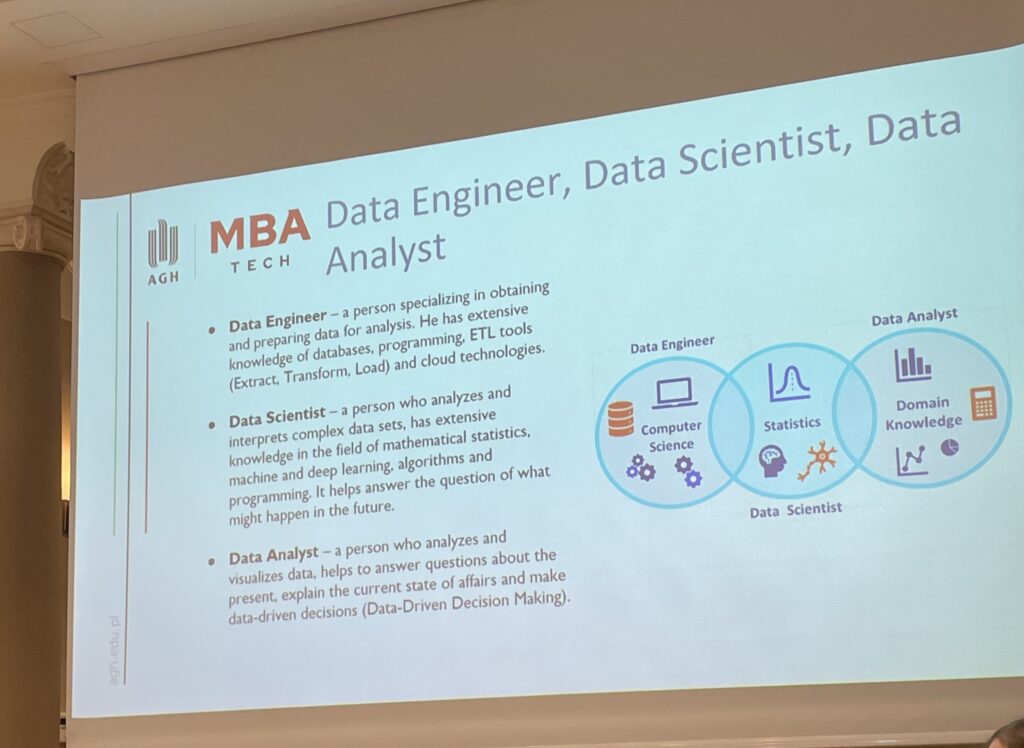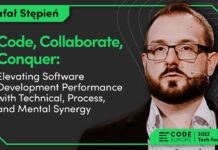In an era where information flows faster than ever and customer expectations are constantly shifting, making better business decisions has never been more critical—or more complex. This three-day MBA Tech module, led by Paweł Przybyłowicz, Karolina Henzel, and Piotr Lipnicki, took us deep into the practicalities of building organizations that are not only data-informed, but truly data-driven.
Here’s a reflection on the key lessons, use cases, and mindset shifts that shaped my perspective.
Day 1: Laying the Foundation – What It Means to Be Data-Driven
We began by exploring what it really means to become data-driven—and the many misconceptions around it. It’s easy to assume that throwing in a dashboard or buying an AI license qualifies, but the truth is more nuanced and foundational.
We broke down the key players in the AI/data value chain:
- Data Engineers – Specialists in collecting, cleaning, integrating, and preparing data. Without them, even the best models collapse.
- Data Scientists – The predictive wizards. They answer „what might happen next?”
- Data Analysts – The explainers. They help us understand what’s happening right now and why.

But the real impact happens when business teams start asking better questions and understand the logic behind models and predictions. One recurring statement from our discussions: „Data quality is not an IT problem—it’s a business problem.”
We took a step back to understand how AI evolved from early concepts to today’s real-world business applications. From early rule-based systems to modern deep learning architectures, the common challenge has remained the same: ensuring data consistency and relevance.
Modern AI systems, particularly those used in production and business forecasting, are incredibly sensitive to data discrepancies. Algorithms can quickly lose accuracy if the input data drifts—whether due to organizational changes, market behavior, or even updates in how data is labeled across departments. As we discussed in class, „data must be aligned across the organization and between companies,” or the risk of failure rises dramatically.
Today’s AI models, such as those used in customer behavior forecasting or price prediction, require a strong foundation of clean, timely, and well-contextualized data. Unlike traditional analytics that rely on historical patterns, AI models—especially deep learning and reinforcement learning systems—must constantly adapt to new data while avoiding the trap of overfitting (performing well only on training data).
We also touched on the evolution of AI applications, including:
- Backpropagation, the core of how neural networks learn
- Deep Learning, which allows systems to identify complex patterns without explicit rules
- Generative models that can simulate or augment data
This foundation helped us understand why baseline models are still a critical first step: they provide a reference point before diving into complex architectures. It’s like testing a recipe with simple ingredients before experimenting with exotic spices.
Day 2: Data Culture, Not Just Data Tools
Karolina Henzel (from T-Mobile) brought the internal corporate view. She emphasized that becoming an AI-powered organization is not just about technology—it’s about people, mindset, and culture.
„Less than 40% of companies use data to create new products or business models.”
That stat hit hard. Despite all the tech investments, many companies are still leaving value on the table. Why?
The reasons are surprisingly consistent:
- Poor data structure
- Limited accessibility
- Slow time to market
- Unclear business goals for AI initiatives
We discussed how Żabka uses AI to locate profitable store locations by analyzing over 10 million addresses. The model predicts—with over 99% confidence—which areas are worth investing in.
Another insightful topic was data storytelling. It’s not just about displaying charts—it’s about crafting a narrative that connects data to business goals. Because, as Karolina reminded us:
“Data doesn’t change behavior. Emotions do.”
We also reviewed stats from McKinsey and Gartner:
- 30% of employees’ time is wasted due to poor data quality
- 40% of business initiatives fail because of inaccurate or inaccessible data
To address that, we looked into:
- Lakehouse architecture (bridging data lakes and warehouses)
- Data Mesh (decentralized data ownership)
- Event sourcing for traceable, auditable systems
Karolina stressed empowering business users—not just IT—by teaching them how to explore and visualize data, even create dashboards. This shift reduces dependencies and speeds up time-to-value.
Day 3: Industrial AI, Digital Twins & Real-World Challenges
Day three with Piotr Lipnicki was a sharp turn toward operations, production, and industrial AI. We explored how predictive analytics and digital twins are being used in manufacturing, logistics, and energy systems.
Imagine being able to replicate your factory line or clinic in a virtual model and test process changes without risk. That’s what digital twins do.
Use cases included:
- Predictive maintenance in forklifts
- Anomaly detection in turbines
- Robotic pasta machines modeled after grandma’s recipe 😉
One key insight: many failed AI projects weren’t due to the model—they failed due to resistance to change. People on the ground weren’t ready or didn’t trust the system.
“The hardest part isn’t the algorithm. It’s the adoption.”
Piotr introduced us to the Business Value Assessment framework:
- Don’t talk about abstract KPIs
- Quantify impacts in terms of revenue, downtime, inventory
- Align with financial stakeholders by translating outcomes into Excel logic
He even joked: “At the end of the day, what really matters is the spreadsheet.” And honestly, it’s true. If it doesn’t make financial sense, it won’t scale.
We also touched together with Paweł Przybyłowicz and Andrzej Kałuża on:
- Autoencoders for anomaly detection
- GANs for data augmentation
- Reinforcement learning for robots and autonomous systems
- RAGs and foundation models as next-gen AI frameworks
One topic I plan to explore further is TensorFlow Quantum and how quantum computing could accelerate learning for complex environments.
Final Reflections: Decisions Over Hype
What resonated most with me throughout the module was the balance between ambition and pragmatism. It’s easy to get caught up in the buzzwords—AI, big data, digital twin, etc.—but none of it matters if it doesn’t support real business decisions.
Here’s what I’m walking away with:
- Start small: prove value, build trust, then scale
- Involve business stakeholders early
- Keep models simple unless complexity is absolutely required
- Build a culture where data ownership is shared—not isolated in IT
- Tell stories, not just stats
Ultimately, the path to optimizing business decisions isn’t just about better tools—it’s about better questions, better alignment, and the courage to challenge how decisions have always been made.




![How to configure a test mail server with the Docker? – Cooking notes [EN]](https://rafalstepien.com/wp-content/uploads/2018/07/docker_tests-100x70.png)

